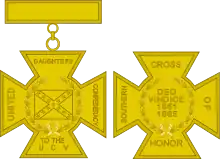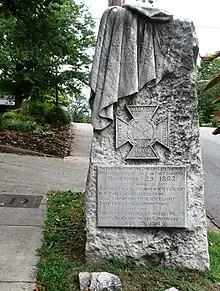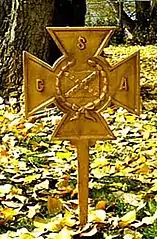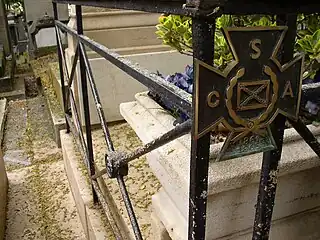| Southern Cross of Honor | |
|---|---|
 Obverse and reverse of the medal | |
| Awarded for | Honorable service in the Confederate States army, navy, or marine corps |
| Date | 1899 |
| Presented by | United Daughters of the Confederacy |
The Southern Cross of Honor was a commemorative medal established in 1899 by the United Daughters of the Confederacy to honor Confederate Veterans.[1]
Design
The Cross of Honor is in the form of a cross pattée suspended from a metal bar with space for engraving. It has no cloth ribbon. The obverse displays the Confederate battle flag placed on the center thereof surrounded by a wreath, with the inscription UNITED DAUGHTERS [of the] CONFEDERACY TO THE U. C. V. (the UCV is the United Confederate Veterans) on the four arms of the cross. The reverse of the Cross of Honor is the motto of the Confederate States, DEO VINDICE ([With] God [as] our Vindicator) and the dates 1861 1865 also surrounded by a laurel wreath. The arms of the cross bear the inscription SOUTHERN CROSS OF HONOR.[1]
History
.png.webp)
.png.webp)
The Cross of Honor was conceived by Mary Ann Erwin, daughter of Confederate politician Howell Cobb, in 1898.[2] [3] She and Sarah E. Gabbett designed it.[3] The first medal was issued on April 26, 1900, to Erwin's husband, Captain Alexander S. Erwin by the Athens (Georgia) Chapter.[4]
Charles W. Crankshaw of Atlanta, Georgia, was chosen as the contractor to produce the medal.[3] Its first manufacturer was Schwaab Stamp & Seal Co. of Milwaukee, Wisconsin. In 1904 the contract was shifted to Whitehead & Hoag of Newark, New Jersey.[2]
Anna Davenport Raines was the Custodian of Crosses of Honor until her death in 1913.[3] Though intended to end in 1913, after the issuance of 78,761 medals, in 1912 it was extended indefinitely.[5] The program finally ended in 1959.[2]
Eligibility and allocation
The Cross of Honor could only be bestowed through the United Daughters of the Confederacy. It could not be purchased; it was given in recognition of loyal, honorable service to the South and only a Confederate veteran could wear it.[4] It was available to any branch of the Confederate military.[2] Only living veterans were eligible. However the final award was given posthumously, in 1951 to Rear Adm. Raphael Semmes.[2] At least 78,761 were awarded.[2]
Although no Civil War veterans are still living, the last verified Confederate veteran dying in 1951, Virginia Code section 18.2-176(b) remains in effect and makes it a Class 3 misdemeanor, punishable by a fine of not more than US$500, to "wear any Southern Cross of Honor when not entitled to do so by the regulations under which such Crosses of Honor are given."[6] An unofficial analog of the Union's GAR Medal, its wearing was never authorized on U.S. military uniforms.[7]
Headstones and markers
The Cross of Honor is also used as an emblem or marker on the graves of Confederate veterans. It will only be issued by the Department of Veterans Affairs to be placed on graves of Confederate veterans. [8]
Gallery
- The Southern Cross of Honor

 Historical United Daughters of the Confederacy Southern Cross of Honor marker
Historical United Daughters of the Confederacy Southern Cross of Honor marker Standard government headstone for unknown Confederate soldier with a Southern Cross of Honor emblem in Beechgrove, Tennessee
Standard government headstone for unknown Confederate soldier with a Southern Cross of Honor emblem in Beechgrove, Tennessee Sons of Confederate Veterans Southern Cross of Honor marker at the grave of Confederate States Secretary of State Judah Philip Benjamin at the Père Lachaise Cemetery in Paris, France
Sons of Confederate Veterans Southern Cross of Honor marker at the grave of Confederate States Secretary of State Judah Philip Benjamin at the Père Lachaise Cemetery in Paris, France Civil War veteran in United Confederate Veterans (UCV) uniform wearing a Southern Cross of Honor
Civil War veteran in United Confederate Veterans (UCV) uniform wearing a Southern Cross of Honor_-_From_C.R._Yancy%252C_the_photographer%252C_Tyler%252C_Texas_LCCN2017658728.jpg.webp) Member of Albert Sidney Johnston Camp, No. 48, UCV, Tyler, Texas, wearing a Southern Cross of Honor
Member of Albert Sidney Johnston Camp, No. 48, UCV, Tyler, Texas, wearing a Southern Cross of Honor
See also
References
- 1 2 United Daughters of the Confederacy. History Committee. (1956). The History of the United Daughters of the Confederacy. Volume I and Volume II: 1894-1955. Raleigh, North Carolina: Edwards & Broughton Company. pp. 145–150. LCCN 94135238.
- 1 2 3 4 5 6 Alexander, David T. (November 30, 2012). "Southern Cross of Honor: Whitehead & Hoag wins contract". Coin World. Retrieved January 24, 2019.
- 1 2 3 4 "Southern Cross of Honor". UDC Stephen Elliot Chapter #1349. Retrieved January 24, 2019.
- 1 2 Inscoe, John. The Civil War in Georgia. University of Georgia Press, 2011. p. 203.
- ↑ Michael Andrew Grisson (September 30, 1989). SOUTHERN BY THE GRACE OF GOD. Pelican Publishing Company. p. 84. ISBN 978-1-4556-1217-8.
- ↑ "Code of Virginia". Commonwealth of Virginia. Retrieved June 14, 2016.
- ↑ Tucker, Spencer C. (September 30, 2013). American Civil War: The Definitive Encyclopedia and Document Collection [6 volumes]: The Definitive Encyclopedia and Document Collection. ABC-CLIO. p. 2202. ISBN 978-1-85109-682-4.
- ↑ "Pre-World War I Era Headstones and Markers". U.S. Department of Veterans Affairs. Retrieved June 14, 2016.
Further reading
- Bertram, Peter (2003). The Southern Cross of Honor: Historical Notes and Trial List of Varieties. Little Greybook #2. Atlanta, GA: P. Bertram. OCLC 55128888.
- Buzzett, Isabell Smith (ed.). "Crosses of Honor Awarded by Atlanta Chapter No. 18, United Daughters of the Confederacy, from 1900 to 1935". RootsWeb. Retrieved September 9, 2018.
- Giambrone, Jeff T. (2013). "Southern Cross of Honor Records at the Mississippi Department of Archives and History". The Primary Source. 32 (2). doi:10.18785/ps.3202.03. Retrieved June 23, 2018.
- "List of Recipients of The Southern Cross of Honor, Henry County, GA". Cemetery Research Group, Henry County, GA. Retrieved September 9, 2018.
- Meares, Catherine de Rosset (January 19, 1901). Address by Mrs. Gaston Meares (Speech). Presentation of the Cross of Honor to Veterans of the Confederate Army by Cape Fear Chapter, Daughters of the Confederacy. Wilmington, N. C.: Review Job Office Print. OL 24610726M. Retrieved April 22, 2016 – via Internet Archive.
- Northcutt, Dolly (ed.). "Southern Cross of Honor Recipients, R. B. Levy Chapter, United Daughters of the Confederacy, Longview, Texas". RootsWeb. Retrieved September 9, 2018.
- Rice, Charles (ed.). "Southern Cross of Honor Recipients, Huntsville, Alabama, from Madison, Jackson, and Marshall Counties". RootsWeb. Retrieved September 9, 2018.
- "Southern Cross of Honor Recipients, Athens, Georgia, April 26, 1900". RootsWeb. Retrieved September 9, 2018.
- "Southern Cross of Honor Recipients, Atlanta, Georgia, April 26, 1900". RootsWeb. Retrieved September 9, 2018.
- "Southern Cross of Honor Recipients, David O. Dodd Chapter No. 212, United Daughters of the Confederacy". RootsWeb. Retrieved September 9, 2018.
- "Southern Cross of Honor Recipients, Little Rock, Arkansas". RootsWeb. Retrieved September 9, 2018.
- "Southern Cross of Honor Recipients, Texas Division, UDC". Texas Division, United Daughters of the Confederacy. Retrieved September 9, 2018.
External links
- A Guide to the United Daughters of the Confederacy, Southern Cross of Honor Records, 1905-1941 Archived June 22, 2018, at the Wayback Machine at James Madison University
- Unidentified Civil War veteran in United Confederate Veterans uniform with Southern Cross of Honor medal at the Library of Congress